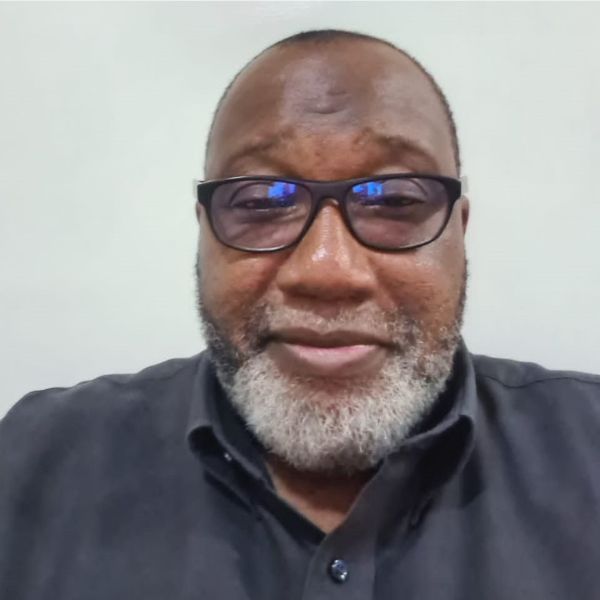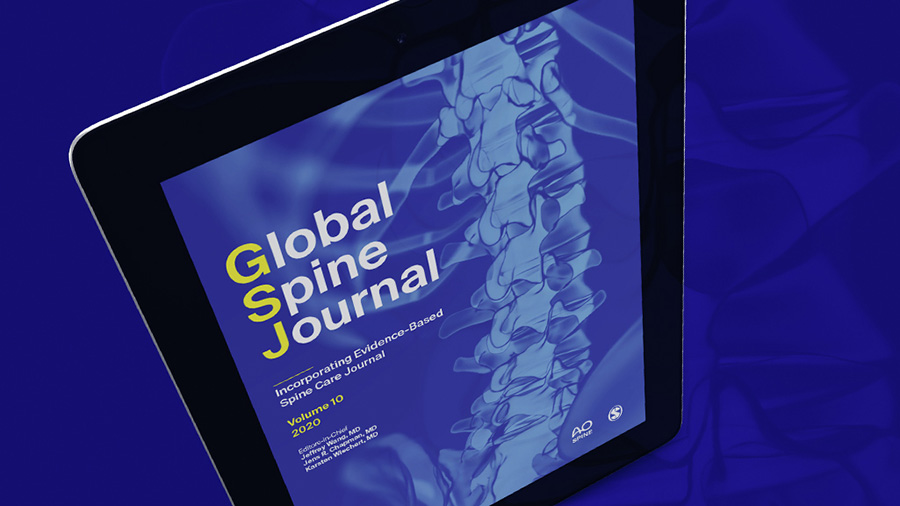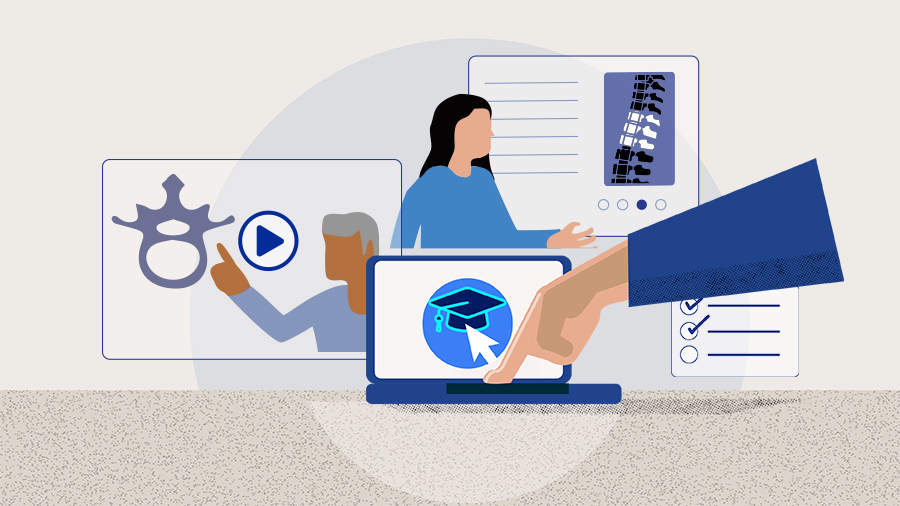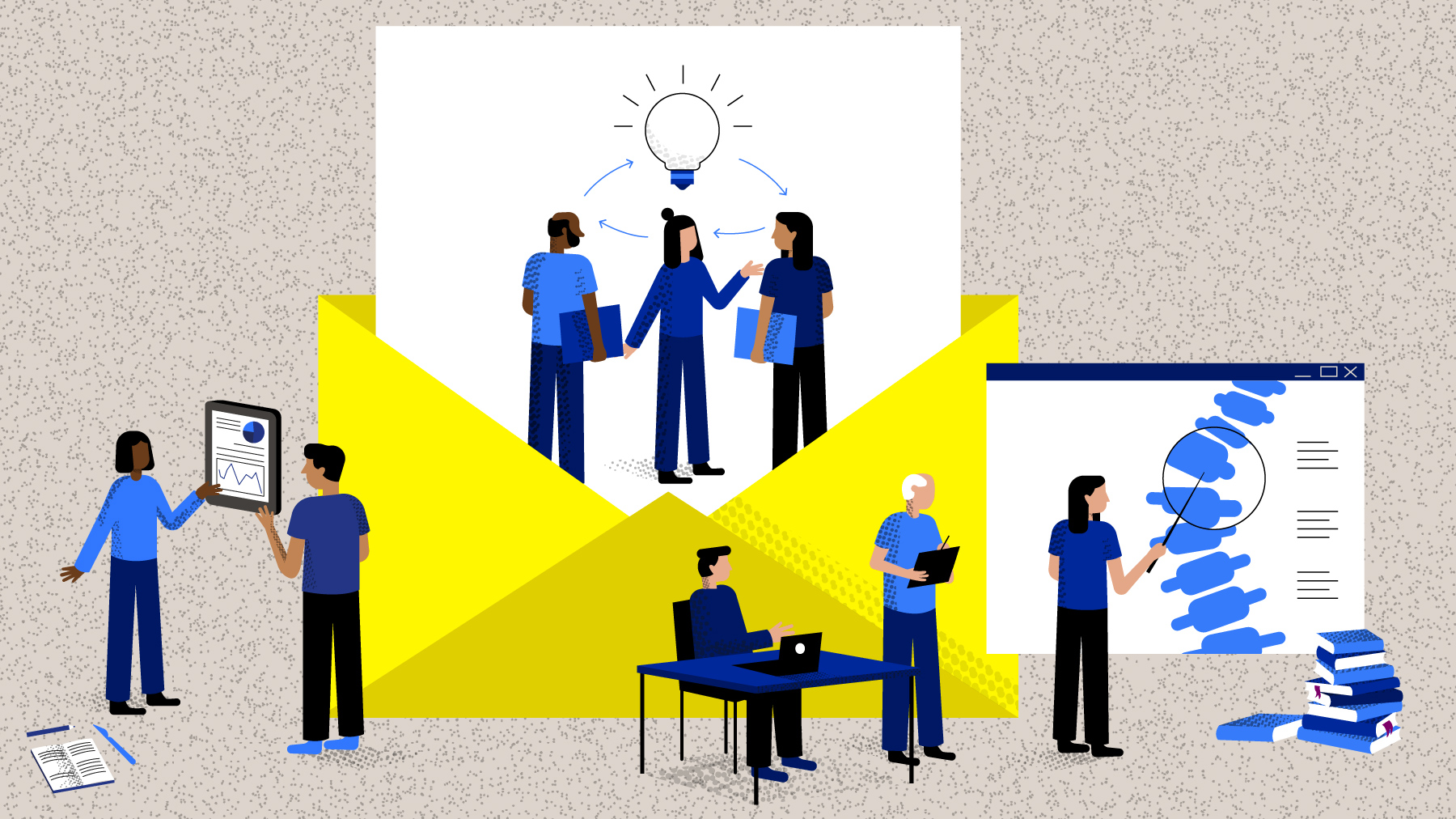Low back pain generators—what causes low back pain and how to classify it

Low back pain affects millions of people every year, and it can have debilitating effects. According to the World Health Organization (WHO) and the recently released WHO Guidelines on Low Pack Pain (LBP), it is the single leading cause of disability around the globe. The causes and symptoms of low back pain can vary greatly. Proper diagnosis and treatment can therefore be a challenge, and maintaining a comprehensive overview is key to successful management.
Disclaimer: The article represents the opinion of individual authors exclusively and not necessarily the opinion of AO or its clinical specialties.
This first part of a two-part guest blog post looks at the causes and the classifications of LBP. Part two focuses on the approaches to management of LBP.
Pain affecting the region between the lower edge of the ribs and the buttock is called low back pain, and it has many ways of manifesting. Patients can describe it as a dull or a sharp type of pain. It may be acute or chronic, and pain may radiate to other regions of the body such as the legs. In many cases, LBP will impair a patient’s ability to move, which in turn can have negative effects on their economic and social life. LBP can also disturb sleep and influence mood.
In 2020, 619 million patients around the world were affected by low back pain. However, with demographic change and increasing population, the figure is expected to increase to 843 million by 2050.
In my home country Nigeria, the prevalence of LBP among adult patients is comparatively high. It ranges between 32.5 and 73.5 percent, with a recent study of hospital patients featuring a point prevalence of 46.8 percent. Among the main contributing factors to low back pain are abdominal obesity—a waist circumference of 88 centimeters or more, previous history of back injury, physically demanding working conditions and, in women, dysmenorrhea.
A study released in 2011 found that a relatively large number of adolescents in Nigeria presented with mild cases of low back pain, which got worse with increasing age. Major contributing factors in this group included commercial activities and other money-making endeavors outside the home, often where patients had to help their parents.
The good news is that while it can be very debilitating, low back pain is one condition in which the greatest number of patients will benefit from rehabilitation. Interventions that can successfully prevent LBP include a modified lifestyle, improvements in posture, increased physical activity and better information dissemination to patients.
An intricate system
However, from looking at the complex anatomy of the lower back, it quickly becomes clear that there are numerous ways in which pain can present. The lower back extends through the lumbar and the sacral vertebrae; each level in the lower back contains three joints, one anterior and two posterior joints, At every level, the anterior joint is the intervertebral discs (IVD) joint—each IVD consisting of the outer anulus fibrosus and the inner nucleus pulposus , also every level has an assortment of ligaments: including the anterior, posterior longitudinal ligaments, also the yellow ligaments—the ligamenta flava—that run between the laminae of adjacent vertebrae. In addition, there are also interspinous, supraspinous ligaments and intertransverse ligaments.
The ligaments are surrounded by different muscular layers. This entire construction, consisting of bone, muscle, and ligaments, working together to support the back. It also provides a measure of protection for the retroperitoneal organs and with the pelvic bones, they protect the pelvic organs.
Potential low back pain generators
There are various theories on how lower back pain can arise. Moving outwards from the innermost components of the lower back, the first possible source of LBP are the vertebral bodies. These bodies are covered with periosteum, a membrane that is rich in nociceptive nerve endings. These receptors can sense signals from damaged tissue, and therefore any aggressive manipulation or disruption of the periosteum will generate pain for the patient.
Another potential source of pain are the individual intervertebral discs. The outer portion of the disc, called the anulus fibrosus, is richly innervated by afferent pain nerve fibers. The disc’s inner part, the nucleus pulposus, is rich in phospholipase A2. This enzyme plays an important role in the arachidonic pathway, which in turn can of course be a major factor in terms of pain generation. In addition, both the anulus as well as the nucleus can act as pressors on traversing and exiting nerve roots also generating neuropathic pain.
Next are the spinal ligaments, which contain stretch receptors. When ligaments are stretched beyond their limits, they get torn or strained and generate pain. The ligaments also contain nerve endings. For example, the posterior longitudinal ligament is innervated by the sinuvertebral nerve as well as a lot of free nerve endings. While the anterior longitudinal ligament receives innervation from the gray rami communicantes and the ventral rami. These nerves conduct nociceptive sensations, same also holds true for the supraspinous and the interspinous ligaments.
When activated, the pressure and stretch receptors in the spinal muscles can also act as pain generators. Furthermore, the accumulation of toxic metabolites such as lactic acid is another potential source of pain in these muscles.
The facet joints are like small knee joints, as I often call them this is because they are encased in capsules and, like the knee joint, they contain cartilage to allow for smooth movement at the intersection of two bones and to protect the very sensitive subchondral area. facet joints have high density of mechanosensitive afferent nerve fibers that are nociceptive, so they are a potential source of pain. They also have low-threshold afferent fibers that modulate proprioception. They are innervated by the medial branches of the dorsal rami of the vertebrae above and at the same level.
Classifying low back pain
Whenever we attempt to classify low back pain, it is important to remind ourselves that LBP is merely a symptom that points to an underlying disease.
Different types of LBP are prevalent amongst different age groups. For instance, the main causes in infancy and adolescence are infections and spondylolysis. Among young male adults, premature disc degeneration, disc herniation, spondyloarthropathies and trauma represent the most common causes of low back pain. In middle-aged and older patients, nine out of ten LBP cases are caused by disc degeneration and its consequences. In the older age groups, red flag LBPs become commoner causes include infections, osteoporotic compression fractures and tumors. this is in addition to causes found in middle aged groups.
The most widely used LBP classification system is the aetiologic classification, which organizes low back pain into five groups. Apart from spondylogenic aetiologies, there are also neurogenic, viscerogenic, vasculogenic, and psychogenic aetiologies.
Spondylogenic low back pains
Spondylogenic LBPs are disorders of anatomic components of the spine such as bones, facet or sacroiliac joints, or soft tissues including the muscles, ligaments, or intervertebral discs. As a general principle, these spondylogenic pains are often aggravated by motion and, conversely, relieved by rest. However, this is not always the case. Spondylogenic LBPs include degenerative Lumbar spine diseases, inflammatory diseases, trauma, infection, tumors, metabolic diseases, and non-specific low back pain, and it is worth looking briefly at some of these conditions:
- Degenerative lumbar spine diseases, or rather degenerative disc conditions, are comparatively common. They are often age-related and can be aggravated by lifestyle, disease, infection, or trauma. The resulting discogenic pain is commonly made worse by sitting, bending, lifting, or straining. In relation to disc degeneration, discogenic pain will often precede facet osteoarthritis, as degenerative disc conditions are usually harbingers or precursors of facet degeneration. Facet degeneration is often associated with abnormalities of the rhythm of the movement at joints of the back. It may or may not be associated with radicular pain and symptoms and is often worsened by extension type activities. There presentation as well as the magnitude of pain is usually a factor of mechanical, psychosocial, and neuropathic contributors. Pain may be relieved partially with rest.
- Another LBP of spondylogenic aetiology is inflammatory spine pain. Among the causes are conditions such as spondyloarthropathies, ankylosing spondylitis, psoriatic and reactive arthritis, and enteropathic spondyloarthropathies. Patients are genetically predisposed to these conditions, and their onset is often insidious. Another typical feature of inflammatory LBPs is that they tend to be worse after periods of rest. Symptoms such as stiffness are often worse in the morning and will improve with activity. Similarly, the stiffness will come back after prolonged inactivity during the day. One of the major differences between inflammatory and degenerative spine pain is that the former often worsens with inactivity while the later gets better. Also, the former involves other non-spinal joints such as in the hips, shoulders, hands, and feet. Corresponding x-ray images are also usually different, showing squared vertebral bodies, the so-called bamboo spine, sacroiliac pseudo-widening erosion, sclerosis of the sacroiliac joint, and periostitis and spurs at the enthuses.
- Trauma as a cause of low back pain is characterized by varying onsets and varying degrees of severity. Minor injuries, which may only affect the soft tissues around the low back, can result in mild to moderate pain. Its onset is often delayed and may initially present as discomfort, with the pain getting worse over subsequent days and possibly resulting in intermittent pain, or at times it becomes a chronic pain condition. Major traumas, on the other hand, usually result in severe pain with an immediate onset severe pain which may also be associated with neurologic deficits.
- Practicing in a tropical climate, one regularly encounters infection as a cause of LBP. Pyogenic infections have replaced mycobacterial infections as the most common cause, as treatment options for the latter have much improved with the advent of good antibacterial drugs. Fungal infections can also lead to LBP. The pain is usually worse at night and during times of rest. Infection-induced LBP is often associated with night sweats as well as chills. There may have been a history of the infection in other parts of the body. In children, there is often a history of respiratory tract infection, while elderly patients often present with urinary tract infections. This is more common amongst immunocompromised patients, such as diabetics or HIV patients and Steroid users. Also susceptible are children, juveniles who engage in drug abuse, and elderly patients.
- Primary or secondary tumors can also cause spondylogenic LBP, pain is often constant and worst during periods of physical inactivity. Vertebral destruction and instability are associated with mechanical pain. Many tumor patients have associated constitutional symptoms such as weight loss, malaise, appetite loss, and at times even associated infections in other parts of the body. Primary tumors, such as lymphoma or haemangioma, and secondary tumors in the breast, lungs, thyroid, kidneys, prostate, and the larger intestines are common.
- Osteoporotic fractures are also among the possible causes of spondylogenic LBP. They are common in postmenopausal and elderly women but can also be seen in younger patients who indulge in steroid abuse. Also at a higher risk are younger women who have had certain gynecological surgeries. Osteoporotic fractures usually occur because of multiple subtle traumas but may also be caused by a single event. The associated LBP has an immediate onset, and there may also be associated neurological deficits. The pain is often constant and severe, and is aggravated by movement, physical activity, and weight bearing. Most patients will complain that their pain is worse in sitting positions because often, it will be an exhale type pain.
Non-spondylogenic low back pains
LBPs can also have underlying causes in parts of the body other than the spine. These are known as non-spondylogenic LBPs, and they can be classified into the following four categories:
- Neurogenic low back pains originate in the lumbar nerve roots, often because herniated or bulging discs cause irritation or tension. Compression, such as in spinal canal stenosis, can also be a cause. Subtle tumors including neurofibroma, neurilemmoma, ependymoma as well as cysts and other tumors involving the nerve roots can also lead to neurogenic LBP. In addition, arachnoid irritation from any cause as well as tumors of the spinal dura may also cause this type of low back pain.
However, apart from the pain, there are usually also accompanying neurologic components such as numbness, or weakness. Some patients may also experience associated bisphincteric dysfunction.
- Vasculogenic low back pains usually originate from large blood vessels around the spine in the retroperitoneal space. One common cause is an abdominal aortic aneurysm, another is peripheral vascular disease. An abdominal aneurysm typically presents with boring-type deep-seated lumbar pain that is not usually related to activity.
- Superior gluteal artery insufficiency presents with buttock pain resembling claudication that is aggravated by walking and relieved by standing still. The pain may radiate to the leg much like sciatic pain does. Vascular pain can usually be differentiated by the fact that it is not precipitated by activities that puts stress on the spine such as bending, stooping, or lifting.
- Viscerogenic low back pains do not originate in the spine but rather in the visceral structures in the retroperitoneal area. These include the kidneys, the lungs in the proximal lumbar spine area, the pleura, the pancreas, the gallbladder, and the rectum, the intrapelvic organs, and the pelvic viscera.
- In female patients, the uterus, the fallopian tubes, and the ovaries; in males, the prostate may be the cause. When any of these organs are diseased, they may cause LBP. However, cases that do present with low back pain are often either tumorous, or there is some type of infection. It may be a sign that a patient requires urgent attention.
- Pure psychogenic low back pain is rare, but it can be a component of chronic low back pain in some patients. In other cases, psychological conditions can go along with low back pain, and it can create confusion in terms of arriving at a clear clinical picture. Thorough investigation and evaluation of the patient will often help in the analysis.
Broadly speaking, the question whether pain comes from the organs, or the spine can often be answered by looking at a patient's history and physical examination. Viscerogenic back pain is neither aggravated by activity, nor is it relieved by rest, so patients with severe viscerogenic pain will often writhe and move around in the hope of getting relief. Spondylogenic pain patients on the other hand tend to lie perfectly still.
Continue reading to part 2 of this Guest Blog post on approaches to management of low back pain
About the author:
Dr Mustapha Alimi is Medical Director at National Orthopaedic Hospital, Lagos, Nigeria (NOHIL), which is also an AO Spine Training Center. He is a member of the AO Spine West Africa Council and Vice President of the Nigerian Spine Society. Dr Alimi was one of the driving forces behind the establishment of the Nigerian Spine Society.
You might also be interested in:
Submit your ideas for guest articles
AO Spine Guest Blog highlights views and perspectives from the global spine community, showcasing experiences, controversies, and knowledge.
Global Spine Journal
AO Spine’s official scientific journal focuses on all aspects of the study and treatment of spinal disorders, including emerging research and clinical developments.
Courses and events
Explore the upcoming AO Spine courses, webinars, and online events in your region or worldwide.
AO Spine Newsletters
Don’t miss a beat! Be the first to hear about open calls, new publications, and tools—all that’s happening in the AO Spine community.






